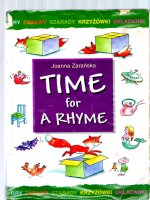nursery rhyme readers hickory dickory dock
Bạn đang xem bản rút gọn của tài liệu. Xem và tải ngay bản đầy đủ của tài liệu tại đây (8.51 MB, 14 trang )
Hickory,
Dickory, Dock
Illustrated by Mick Reid
No part of this publication may be reproduced in whole or in part or stored in a retrieval system, or transmitted in any
form or by any means, electronic, mechanical, photocopying, recording, or otherwise, without written permission of the
publisher. For information regarding permission, write to Scholastic Inc., 557 Broadway, New York, NY 10012.w
Designed by Jaime Lucero
ISBN: 978-0-545-26719-9
Copyright © 2010 by Scholastic Inc.
All rights reserved. Published by Scholastic Inc.
12 11 10 9 8 7 6 5 4 3 2 1 10 11 12 13 14 15/0
N
u
r
s
e
r
y
R
h
y
m
e
N
u
r
s
e
r
y
R
h
y
m
e
READERSREADERS
Nursery Rhyme Readers: Hickory, Dickory, Dock © Scholastic Teaching Resouces
2
Hickory, dickory, dock,
Nursery Rhyme Readers: Hickory, Dickory, Dock © Scholastic Teaching Resouces
3
the mouse ran up the clock.
Nursery Rhyme Readers: Hickory, Dickory, Dock © Scholastic Teaching Resouces
4
The clock struck one.
Nursery Rhyme Readers: Hickory, Dickory, Dock © Scholastic Teaching Resouces
5
The mouse ran down.
Nursery Rhyme Readers: Hickory, Dickory, Dock © Scholastic Teaching Resouces
6
Hickory,
Nursery Rhyme Readers: Hickory, Dickory, Dock © Scholastic Teaching Resouces
7
dickory,
Nursery Rhyme Readers: Hickory, Dickory, Dock © Scholastic Teaching Resouces
8
dock.
Nursery Rhyme Readers: Hickory, Dickory, Dock © Scholastic Teaching Resouces
6
Teaching Tips
To enhance children’s reading experiences, use these tips
as you introduce and share the Nursery Rhyme Readers.
Before Reading
Show the cover of the book and read aloud the title.
Have children comment on the cover illustration and
tell what they know about the nursery rhyme. Since
nursery rhymes often contain unfamiliar vocabulary,
skim the book and introduce any vocabulary that will help
children’s understanding of the story. For example, for Little
Miss Muffet, discuss tuffet, curds, and whey.
During Reading
The first time through, read the nursery rhyme aloud from beginning to end to let children hear the
rhyme, enjoy it, and get a feel for the language. On subsequent readings, help engage children in the
reading process by following these suggestions.
L
Model reading for children by tracking a line of print from left to right, turning the pages, and
using picture clues. Invite children to comment on the illustrations on each page.
L
Reread the story, asking children to listen for words that rhyme. Then read aloud again, this time
stopping at words that rhyme and letting children chime in on them. Next, invite children to join
in for a shared reading, pointing to each word as you read it.
L
Model strategies for decoding words, such as finding beginning sounds, using picture clues, and
sounding out words.
L
Point out punctuation and capital letters. Discuss what symbols such as periods,
commas, questions marks, and exclamation marks mean, and how they affect the
reading of the rhyme.
L
Invite children to clap their hands along with you to the rhythm of the rhyme as
you read aloud.
After Reading
Help children respond to the nursery rhyme by following these suggestions.
L
Ask questions to check for understanding. For example, after reading
Humpty Dumpty, ask questions such as: What happened to Humpty when he
fell? Who tried to help Humpty after he fell? Why couldn’t the king’s horses and
men put Humpty back together?
Nursery Rhyme Readers Teaching Guide © Scholastic Teaching Resources
7
L
Ask children if they liked the rhyme, and what they liked most or least.
Have them retell the rhyme in their own words.
Using the Reproducible Nursery Rhyme Pages
After reading a nursery rhyme several times, give children a copy of the nursery
rhyme reproducible to use for independent reading, for reading in pairs or groups,
for classroom activities, and for sharing with
family members. These pages are a great way to
encourage repeated readings, develop fluency, and
to do specific skill work.
Have children make a folder of the nursery
rhyme pages. Provide a blank folder for children to
title “My Nursery Rhymes,” and let them decorate
it. Have them insert the nursery rhymes as they read
them. They can also keep the Nursery Rhyme
Reader Log in the folder, as well as activity
sheets that they complete. Let children take
home the folder to share with family members
from time to time.
Have children follow along as you read
the rhyme, tracking the print as you read. Ask them to underline or circle
the rhyming words on their sheet. Also use the pages to have children
identify specific letters, words with specific consonants, blends, vowel
patterns, phonograms, and sight words. (You might wish to enlarge one copy
of the rhyme and place it on an easel for children to see.)
Some of the lesson pages have specific suggestions for using the reproducible
versions of the nursery rhymes.
Using the Lesson Pages and Reproducible
Activity Pages
For each Nursery Rhyme Reader, use the activities on the lesson page found in
this teaching guide to delve further into the areas of phonemic awareness, phonics,
comprehension, vocabulary, reading, and writing. Each nursery rhyme includes a
reproducible activity page specific to it. Spread the lesson and activities for each
rhyme over several days.
Nursery Rhymes Readers Teaching Guide •
© 2010 Scholastic • 26
Mary Had a
Little Lamb
Mary had a little lamb
with fleece as white as snow.
And everywhere that Mary went,
the lamb was sure to go.
He followed her to school
one day,
which was against the rule.
It made the children laugh and
play to see a lamb at school.
Nursery Rhymes Readers Teaching Guide •
© 2010 Scholastic • 42
Name ___________________________________________________________
Mary Had a Little Lamb
Write Your Own Story!
Mary’s lamb followed her
__________________________________________
_____________________________________________________________________________
.
What happened?
_____________________________________________________
_____________________________________________________________________________
.
to soccer
practice.
It got the ball and
butted it into the goal.
Jack
Nursery Rhyme Readers Teaching Guide © Scholastic Teaching Resources
Nursery Rhyme Readers Teaching Guide •
© 2010 Scholastic • 12
Hickory,
Dickory, Dock
Hickory, dickory, dock,
the mouse ran up the clock.
The clock struck one.
The mouse ran down.
Hickory,
dickory,
dock.
13
Hickory, Dickory, Dock
Learning With the Nursery Rhyme
See pages 6–7 for suggested ways to read and share the book with children. Then focus on the
following activities.
You Rhyme It! Have children substitute the words dock and clock at the beginning of the rhyme
to create new rhyming couplets. Tell them they can change other words as well. Provide an example
such as the following:
Hickory, dickory, doo,
the mouse ran into the shoe.
Continue to innovate on the rhyme by replacing the number one in the next line, as in:
The clock struck two.
The mouse turned blue.
What’s the Cause? Use the following questions to review with children what happened in
the rhyme, focusing on the cause and effect of each event. Point out that they can use clues in the
pictures to help them. Why did the mouse run down the clock? (He got scared when the clock struck
one and made a loud sound.) Why did the cat drop the books? (He wanted to catch the mouse.) Why
couldn’t the cat catch the mouse? (The cat tripped over the books.)
Silly Sounds Focus children’s attention on the word BONG! in large type in the picture
on page 4 of the reader. Ask what made the sound. (clock) Then distribute the activity sheet
on page 35. Invite children to write and illustrate their own sound words. Encourage them
to write their sound word in big letters in the speech balloon and then write what made the
sound in the blank. After, children can illustrate their page in the space provided. Post the pages
on a bulletin board entitled “Silly Sounds.”
What’s My Sound? Highlight the words in the rhyme that contain the diphthong /ou/
(mouse, down). Point out that these words share the same sound but have different spellings.
Read a list of words, including some with the /ou/ sound. Have children make a LOUD
SHOUT when they hear /ou/. Ask children to name other words that have the /ou/ sound
and list them on chart paper. Underline the ou or ow spelling in each word.
Clap for Sounds Have children focus on the consonant cluster /cl/ as in clock. Tell them you
are going to read a list of words, and they are to clap only when they hear /cl/ at the beginning of
the word. Say these words: clip, dock, clown, like, close, class, plant. Follow the same procedure for words
that begin with /str/ as in struck. Then isolate the /ck/ sound at the end of these words and repeat
the procedure. Distribute the reproducible version of the nursery rhyme and have children circle the
clusters cl, str, and ck.
Words Around the Clock Have children create a word-wheel clock for the phonogram –ock.
Each child will need two paper plates and a paper fastener. Cut a wedge out of the top plate and
attach it to the second plate in the middle with the paper fastener. Show children how to write
consonants of their choice on the bottom plate, and have them decorate the top plate to look like a
clock. Then instruct children to spin the clock and blend the letters and phonogram to make words,
some of which can be nonsense words. Have children take turns reciting “Hickory, Dickory, Dock”
replacing the word dock with the new words.
Mary Anne
ghost
Boo!
Nursery Rhyme Readers Teaching Guide © Scholastic Teaching Resources
Nursery Rhymes Readers Teaching Guide •
© 2010 Scholastic • 35
name ____________________________________________________________
Hickory, Dickory, Dock
Silly Sounds
went the _________________________________.









